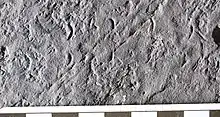Lunulipes
Lunulipes, meaning crescent foot, is an ichnogenus for fossil trackways discovered in shallow lacustrine deposits of the Lower Jurassic Turners Falls Formation of the Deerfield Basin in Massachusetts. These trackways consist of two rows of crescent-shaped tracks, with the tracks in each row arranged one behind the other. Some trackways also exhibit a median furrow. The ichnogenus was originally erected under the name Lunula by Edward Hitchcock,[1] but subsequent workers [2][3] showed that the original name had been used previously for a bryozoan.[4] Getty (2017) subsequently changed the name to Lunulipes, in accordance with International Code of Zoological Nomenclature rules.[5] Only a single species, obscurus, is recognized.
| Lunulipes | |
|---|---|
| Scientific classification | |
| Kingdom: | |
| Phylum: | |
| Subphylum: | |
| Class: | |
| Order: | |
| Suborder: | |
| Infraorder: | |
| Family: | |

Hitchcock (1865) considered the most likely trace maker to be a myriapod. Richard Swann Lull subsequently proposed that the trackway was made by either a crustacean or an unknown arthropod.[6][7] Getty and Loeb (2018), however, noted that published myriapod and crustacean trackways don't strongly resemble Lunulipes. Instead, they proposed that Lunulipes was most likely made by aquatic insects called water boatmen (Family Corixidae), or similar insects, based on the general similarity of the fossil trackways to those made by water boatmen in shallow water in laboratory experiments.[8]
References
- Hitchcock, Edward (1865). Supplement to the Ichnology of New England. A Report to the Government of Massachusetts, in 1863. Boston: Wright and Potter. pp. 96 p.
- Häntzschel, W (1965). Westphal, F (ed.). Vestigia invertebratorum et problematica. Gravenhage: Junk.
- Anderson, A. (1981). "The Umfolozia arthropod trackways in the Permian Dwyka and Ecca Series of South Africa". Journal of Paleontology. 55: 84–108.
- Koenig, C (1825). Icones Fossilium Sectiles: Centuria Prima. London: Sowerby. p. 4.
- Getty, P (2017). "Lunulipes, a replacement name for the trace fossil Lunula Hitchcock, 1865, preoccupied". Journal of Paleontology. 9 (3): 577.
- Lull, Richard (1915). Triassic Life of the Connecticut Valley. Hartford: State of Connecticut. pp. 285 p.
- Lull, Richard (1953). Triassic Life of the Connecticut Valley, Revised. Hartford: State of Connecticut. pp. 336 p.
- Getty, Patrick; Loeb, Samuel (2018). "Aquatic insect trackways from Jurassic playa lakes: Reinterpretation of Lunulipes obscurus (HITCHCOCK, 1865) based on neoichnological experiments". Palaeodiversity. 11: 1–10. doi:10.18476/pale.11.a1.